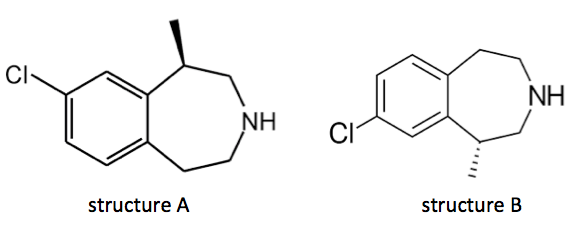Applying IB chemistry to a diet pill
Sunday 23 September 2018
One of the reasons why life expectancy is starting to fall in certain parts of the world is the increase in obesity.

The number of overweight and obese people worldwide has increased from 857 million in 1980 to 2.1 billion in 2013. Of these, 671 million are obese. (Source: Medical News Today)
Recent studies by a team led by Dr Erin Bohula published in the New England Journal of Medicine have identified a drug which can reduce weight in humans. The study, which involved 12,000 people who were either obese or overweight, showed that those who took the drug lorcaserin twice a day lost an average of 4 kg (approximately 9 lbs) in 40 months compared to those who took a placebo. This is not a huge weight loss and dieticians still stress the necessity for a healthy diet coupled with regular exercise. The importance of the study though is that, unlike other appetite suppressers, lorcaserin, appears to have no serious long-term adverse effects on the heart. It is thought to work by suppressing appetite by activating a type of seratonin receptor known as 5-HT2C in the hypothalamus.

lorcaserin
Lorcaserin has an interesting structure and could be used in your teaching to check whether students can apply what they have learned during the course (Topics 10, 11, 18, 20 and Option D) to a real life example.
1. Deduce the molecular formular of lorcaserin.
C11H14ClN (Topic 10.1: Skeletal formulas should be discussed in the course.)
2. Calculate the index of hydrogen deficiency (IHD) of lorcaserin.
C11H14ClN is equivalent to C12H16 so IHD = 5 (Topic 11.3)
3. Predict whether or not lorcaserin will readily undergo an electrophilic addition reaction with bromine.
The extra stability due to the delocalization of electrons in the phenyl functional group means that it will not readily undergo electrophilic addition reactions. (Topic 10.2)
4. Deduce whether lorcaserin is a weak acid, a weak base or a neutral substance.
It will be a weak base as the non-bonding pair of electrons on the N atom can attract a proton. (Topic 18.1)
5. Suggest why lorcaserin is normally administered as a salt, such as lorcaserin hydrochloride.
It will make it more soluble in aqueous solution. Once in the strongly acidic environment of the stomach it will revert back to the unionized form. (Topic D.2)
6. Explain whether structure B represents an enantiomer of lorcaserin as shown in structure A.

They are both representation of the same enantiomer as structure B is simply structure A rotated by 180o.
The correct structure for the enantiomer is 


Comments
To post comments you need to log in. If it is your first time you will need to subscribe.